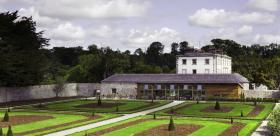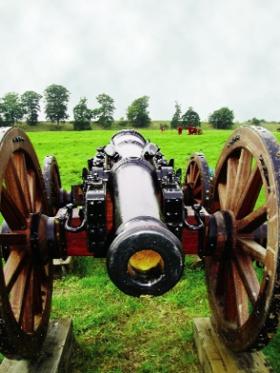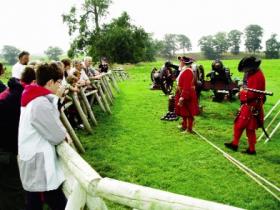Museum Eye
Published in 20th-century / Contemporary History, General, Issue 5 (Sep/Oct 2008), Reviews, Volume 16
Oldbridge House, with the centre’s tea pavilion and garden in the foreground.
Battle of the Boyne Visitor Centre
Oldbridge, Co. Meath
+353 (0)41 9849873, battleoftheboyne@opw.ie, www.battleoftheboyne.ie
Daily 10am–5pm
by Tony Canavan
Given the massive amount of publicity surrounding the opening of this visitor centre, I expected that it would be easy to find, but in fact there is very little in the way of signposting. I nearly collided with the car in front of me as it braked suddenly at the turn-off to read the small brown sign pointing to Oldbridge estate. I witnessed a similar near-collision on my way home. Even when you get to the gates of the estate there is little to indicate that there is a multimillion-euro visitor centre there.
Once you find it, however, Oldbridge House is impressive and the carpark was almost full, which is a good sign. A large plan explained that the estate is divided into five sections: the visitor centre, an artillery exhibition, a tea pavillion (sic), a walled garden and country walks. Two old cannons guard the door to the reception, where the tour begins. On one wall are portraits of the main players in the drama, such as Marshal Schomberg and the duke of Tyrconnell. There is one large map explaining European politics at the time of the battle, and another showing the routes that William and James took through Ireland to the Boyne. The texts accompanying both maps were anodyne and non-committal, and I was to discover that this was a feature of the whole place.

One of several replica cannons on display.
The first room, entitled ‘The Night before the Battle’, has some attractive life-size murals of the soldiers, their weapons and equipment interspersed with information. The room’s main features are two tents. One contains life-size manikins of King James and his advisers deciding on tactics for the forthcoming engagement. Rather oddly, their dialogue is conveyed via subtitles on a TV screen showing battle plans. The second tent has a similar scene for William of Orange. What struck me most was the claim that more soldiers fought in the Battle of the Boyne than in any other engagement in Britain or Ireland, which I find hard to believe, given that some military historians deny that it even qualifies as a battle.
The second room has a display cabinet of the types of weapons used by the armies. A video screen presents images of the battle, mainly by Dirk Maas, the only artist present, and some later representations. Missing were depictions of the battle on Loyalist murals and Orange Order banners, which are surely of more cultural significance. There is a large painting, executed in 2008, based on Maas’s original, which just manages to dominate this section despite a very large photograph of a beaming Bertie Ahern and Ian Paisley at the official opening ceremony. Beneath them is a case holding that musket and a replica of the walnut bowl presented to Revd and Mrs Paisley by the Irish government.
The best feature of the room, and of the whole exhibition, was a very large diorama of the battlefield, with laser displays tracing the course of the action as a narrator took us through the events of the day. Above, TV screens showed scenes from a historical re-enactment. This is a very good way of explaining the battle.
The next room promises to discuss the ‘Outcomes’ of the battle, but frankly they need not have bothered. The consequences are condensed into a few sentences, which say in effect that many Irish soldiers went to the Continent, that the Irish parliament passed something called the Penal Laws but really the eighteenth century was a ‘golden age’, and finally that ‘recognition by the Irish government of the significance of the Battle of the Boyne has contributed to improved relations in modern Ireland’.
Next comes the artillery in the yard. Two cannons, a field mortar and a powder wagon are all nicely displayed and accessible, although climbing is discouraged. An information panel explains about the different guns and equipment and what it took to fire them. Beyond this, in a part of the old stables, a fifteen-minute video shows a historical re-enactment of the battle while a narrator sets it in context. The re-enactment is good but the overall tenor of the narration leaves a lot to be desired. This simple version of history says that the Williamites fought for an independent parliament, the Irish because they were Catholics, and concludes that the Battle of the Boyne was a good thing because it gave us the democracy we all enjoy today. As I was going in to watch this show, a Belfast family was coming out. They were so inspired by this balanced representation of history that they shouted ‘Remember the Boyne! No Surrender!’ before inquiring of the attendant where they could get a cup of tea. Indeed, the sub-text of the entire exhibition seems to be that nothing should be done to offend Northern unionist sensibilities—better to be bland than balanced.

One of several replica cannons on display.
It was with some relief that I got out onto the lawn to find Lynn Williams dressed as a 1690 cavalryman on horseback. She gave a most informative talk on what it takes to be a cavalryman, where his horse came from and how it was trained. The talk was backed up by practical demonstration as she manoeuvred her horse and exercised skills with her sword on an unfortunate melon. An hour later Boyd Rankin appeared as an infantryman and gave a talk and demonstration with matchlock and flintlock muskets. This was the more popular of the two because of the flashes and bangs and because he explained how phrases we all use, like ‘flash in the pan’ or ‘bite the bullet’, have their origin in musketry. Whatever the shortcomings of the exhibition, these two re-enactors made the whole visit worthwhile.
I retired to the tea pavilion to write up my notes. I came to the conclusion that the visitor centre is an opportunity lost. The actual exhibition vis-à-vis the size of the house is very small. I was recently in France on Île d’Aix, where there is a house smaller than Oldbridge but which uses every space available to present an exhibition on Napoleon and his legacy. What are all the other rooms in Oldbridge used for? The opportunity to present what the Battle of the Boyne was really all about and its legacy has been completely ignored. There is not even anything of substance on the Orange Order and its role in Irish history.
If you just want a good day out then Oldbridge House is the place, especially for families. The exhibition can be got through quickly and the re-enactors really make the occasion. After that there are walks through the walled garden and the parkland, while refreshments are on offer in the tea pavilion. If, however, you want a serious exhibition on the Battle of the Boyne and its place in Irish history, you will not find it here, the very place you would expect it.
















